Portugal beat Switzerland in what was a demonstration of the superiority, talent and quality of the squad, in addition to several changes in the game aesthetics of coach Fernando Santos, known for his more pragmatic and positional style of play when he has the ball, which has been criticized of being flat and boring. However, a more functional and rotational game was offered by the manager to his players, who with freedom of movement did a lot of damage to the Swiss, who did not hold back for a minute the speed and agility of the Portuguese, who will face Morocco in quarterfinals of the 2022 World Cup.
Switzerland, after a group stage where they conceded three goals, one from Brazil and two from Serbia in an extremely eventful match heated by the political conflict between Granit Xhaka and Xherdan Shaqiri. They faced Portugal in the round of 16, a team that has historically been very complicated to them and this was one of those that they will try to forget forever. No phase of the game was taken advantage of by Murat Yakin’s team, which was too weak and fragile defensively, but also very confused by Portugal’s game plan.
In this tactical analysis, we dive into the tactics of both teams in form of analysis and see how Fernando Santos tweaked his tactics and won the tactical battle against Murat Yakin.
Lineups
Portugal chose to play with a kind of dynamic 4-3-3 with Digoo Costa in goal, Diogo Dalot as RB, Pepe and Ruben Días as centre-backs and Raphael Guerreiro chosen as LB. The midfield was made up of William Carvalho, Otavio and Bernardo Silva, ending later with Bruno Fernandes, Joao Felix and Goncalo Ramos, the replacement for Cristiano Ronaldo.
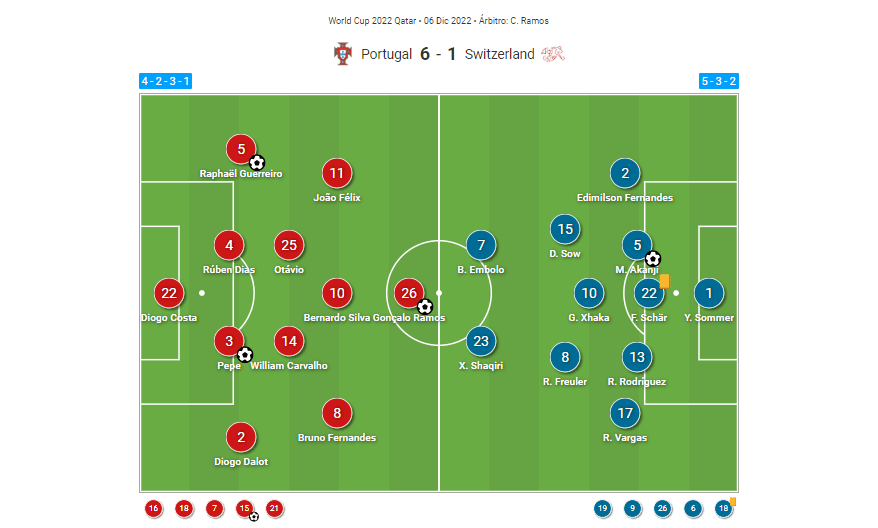
Switzerland looked for defensive solidity with a 5-3-2 with Yann Sommer, Ricardo Rodríguez, Manuel Akanji and Fabian Schar as CBs; Edimilson Fernandes the RWB and on the left Ruben Vargas; Granit Xhaka, Djibril Sow and Remo Freuler in midfield sought to provide passes to Breel Embolo and Xherdan Shaqiri up front.
Portugal’s flexible structure and organised pressing
Portugal changed their image after what was seen in the group stage, where they did not look solid defensively, nor was it fluid in terms of ball and build-up at some times. However, Fernando Santos, after the crushing 6-1 victory against Switzerland, spoke of his “hybrid system” and of a twist he wanted to give the team more functional and mobile roles for each one of them, who have a lot of talent to appear in different areas of the field. He commented that the important thing was to maintain a defensive organisation that allowed them to steal the ball quickly, but then he didn’t care where his players moved when they had the ball.
All this generated multiple chances for Portugal, in addition to the six goals scored, which gave it effective dominance during the match, with high possession of the ball, but with speed and frenzy in each of their attacking ideas, as well as dynamism through of the different phases where the players moved and changed positions and channels constantly.
With players like Bruno Fernandes, Joao Felix, Otavio, Bernardo Silva and their attacking full-backs Diogo Dalot or Raphael Guerreiro, Portugal can execute a game where their pieces interlock with each other, much closer and with rotational movements that completely confuse the opponent about who to go and mark. The idea behind this was to disarm the Swiss middle block, creating a lot of space between their lines.
Portugal in the early stages of the build-up, in their own third, sought to attract pressure close to their box, with William Carvalho joining the centre-back line, four players in the mid lane further up and three attackers up front, two pinning outside and another in between. It was a kind of 3-1-3-3 where the player taking the centre spot of #6 swapped between Otavio and Bernardo, while Bruno, Bernardo/Otavio depending on who dropped off as #6, and Joao Felix/Guerreiro entered this midfield three. Forward, Dalot was usually always wide open on the right, Ramos in the middle and Felix/Guerreiro exchanged heights.
This is a marvellous example of what Portugal tried to do. They looked to equate Switzerland’s three-man pressure with Carvalho inside the first line and then overload the central zones with four players against two from the opponent who were defending on a 5-2-3, but too separated. In this picture, we can see the man joining as a #6 was Otavio, and Guerreiro the one taking the spot as an inverted full-back, with Bernardo and Bruno the other midfielders.
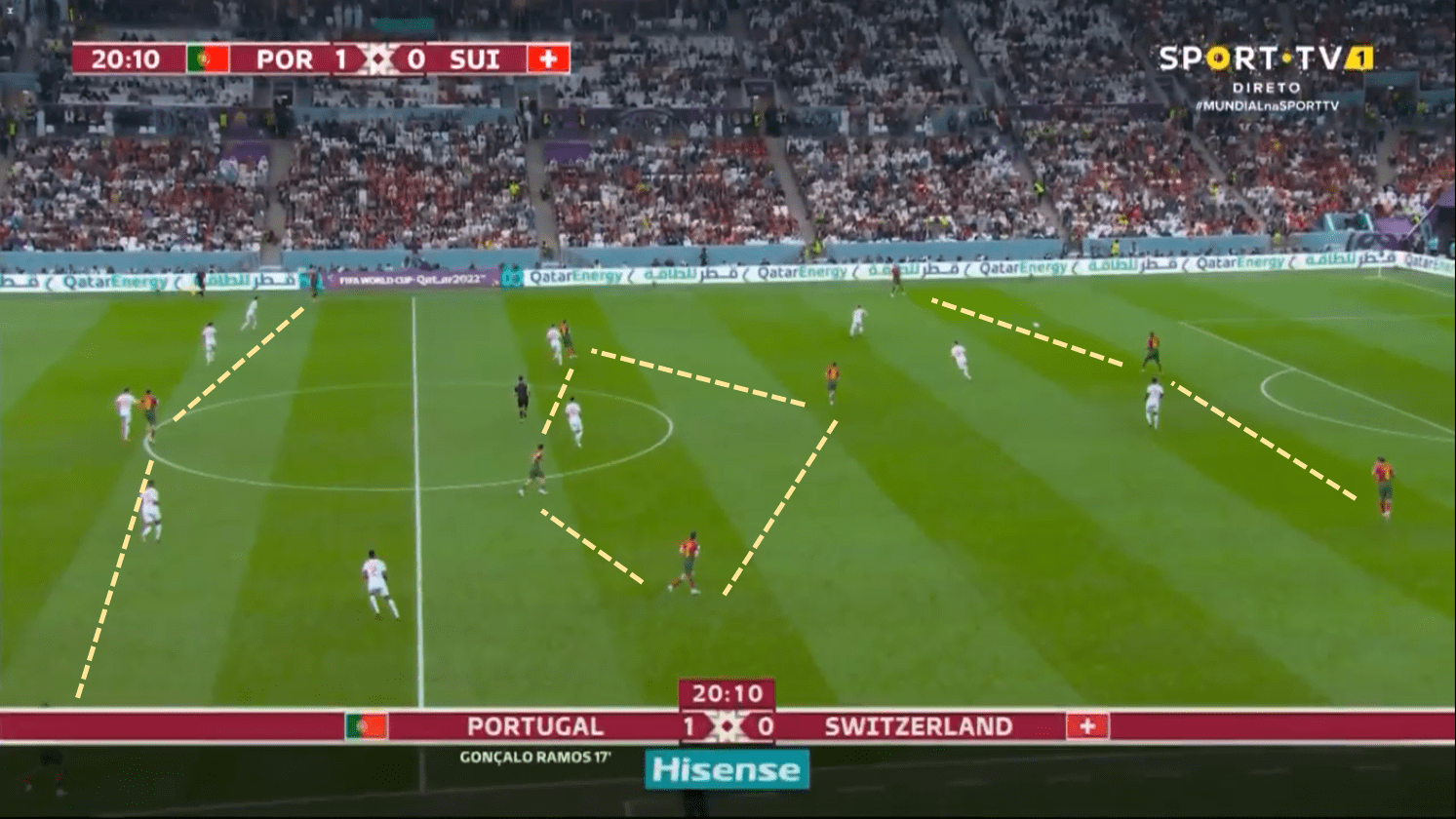
This was also planned by Santos in order to have more quality individual players with the ball trying to evade the first pressure from Switzerland. When attracting, the players who were later going to receive with space to combine and run, were Bruno, Bernardo or Joao Felix at certain times. It was a search for this type of player closer to the ball, in order to carry out very fast and unstoppable build-ups due to rhythm and technical ability for Switzerland.
In this image, we can see how Joao Felix is the one who on this occasion descends to the middle, something that we saw a lot in the first passes from Portugal, and where he had several plays where he started from there and eliminated players with his dribbling and 2-1 combinations. Thus releasing Guerreiro on the outside. In a matter of seconds, the block moved, if Dalot was not pinning wide, Bruno entered and they changed the structure. Switzerland really started to feel uncomfortable and lost throughout the pitch with all these kinds of movements.
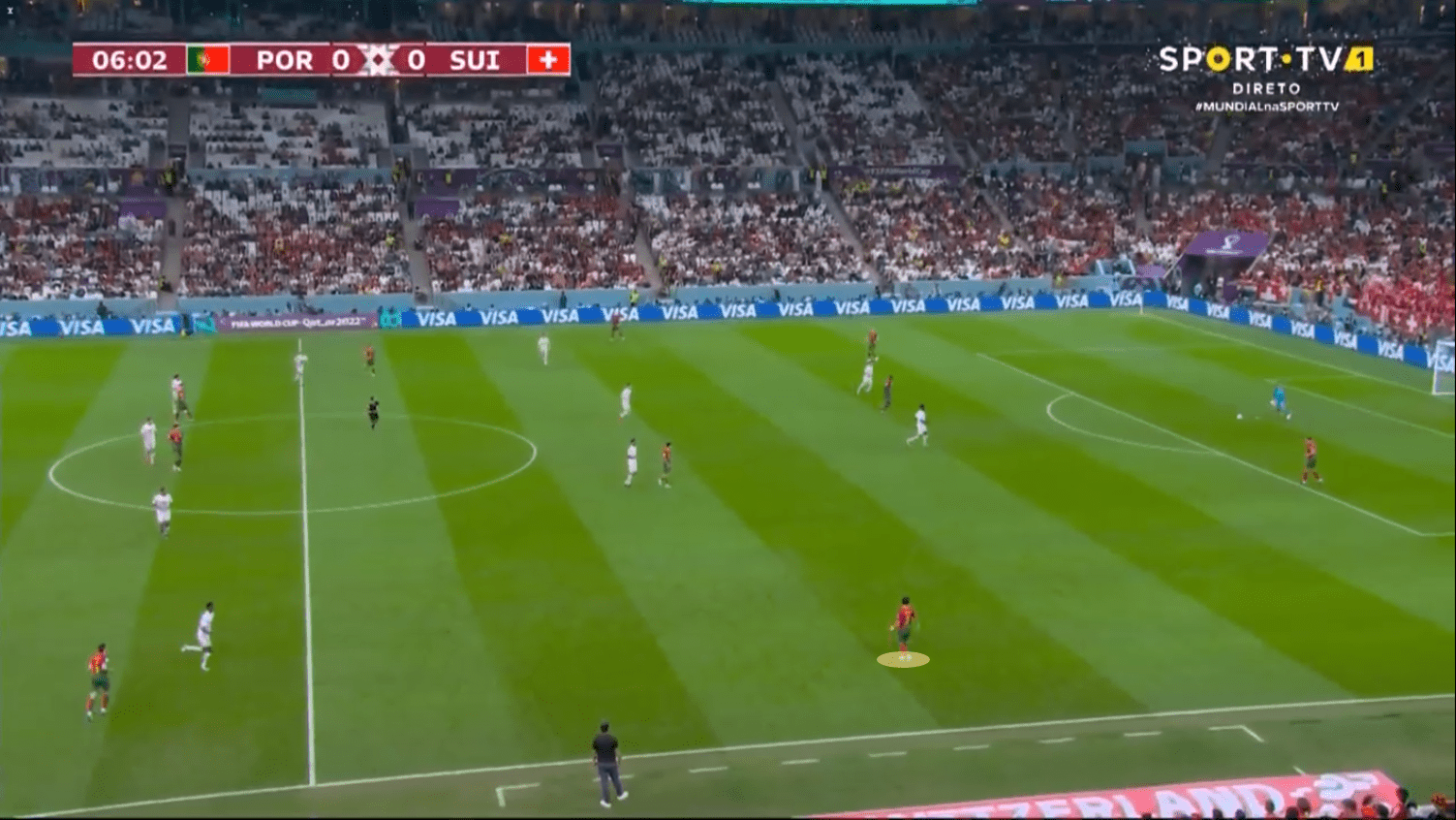
But Portugal did not always seek to maintain these movements, it was extremely normal to see how Bruno Fernandes went wide to receive the ball, facing Bernardo in a kind of double-pivot, but forward Joao Felix taking a position of #10 and Guerreiro in the half-space as an inverted full-back who came into a lot of contact with the ball and his movements gave the team a lot of fluidity.
As you could see Bruno, also Felix or Bernardo himself, who were the triangle of a very dynamic Portugal that was sometimes random and free, which was fun and provided tremendous comfort to players who felt the freedom to take the ball and combine with their teammates at any height, with clearly a lot of superiority in terms of talent. Even at some moments, Otavio would move to the sides, leaving Bernardo as a #6, with Felix or Bruno being near to him.
In this example, we can see Bruno Fernandes, the Manchester United player receiving wide, having Guerreiro inverted, and Felix as a#10. This could be even totally reversed with Bruno as a #10, Felix/Guerreiro wide or at the half-spaces.
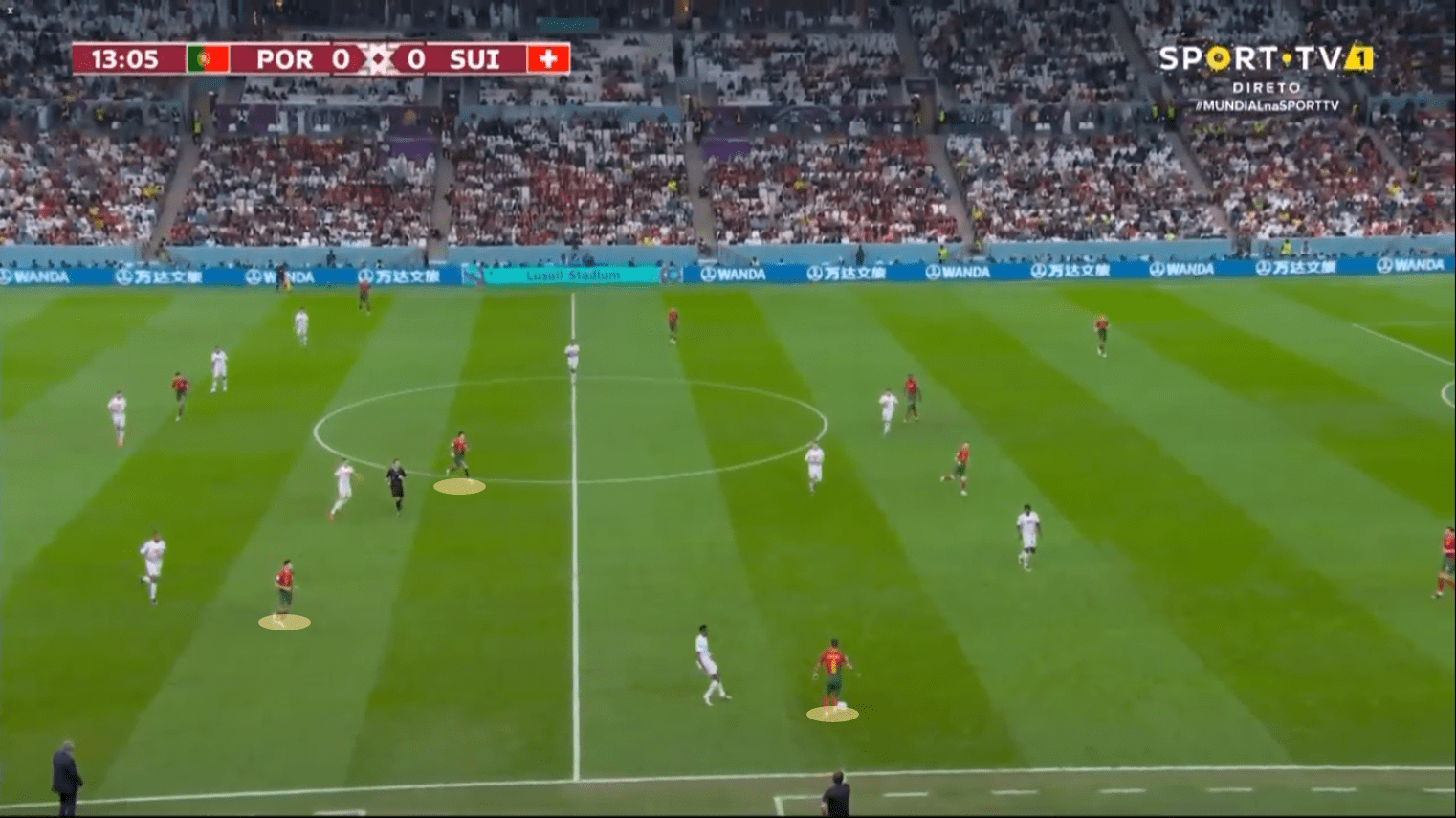
Something that Portugal also looked for in how to speed up their ball possessions was opening the pitch outwards to activate Diogo Dalot into space, who was always pinning very wide in every Portugal build-up. With Carvalho entering the first line, the ball would reach the feet of Otavio or Bernardo who formed a double pivot, which allowed the Manchester City player to appear in areas close to the ball in order to launch long through passes to his full-back Dalot.
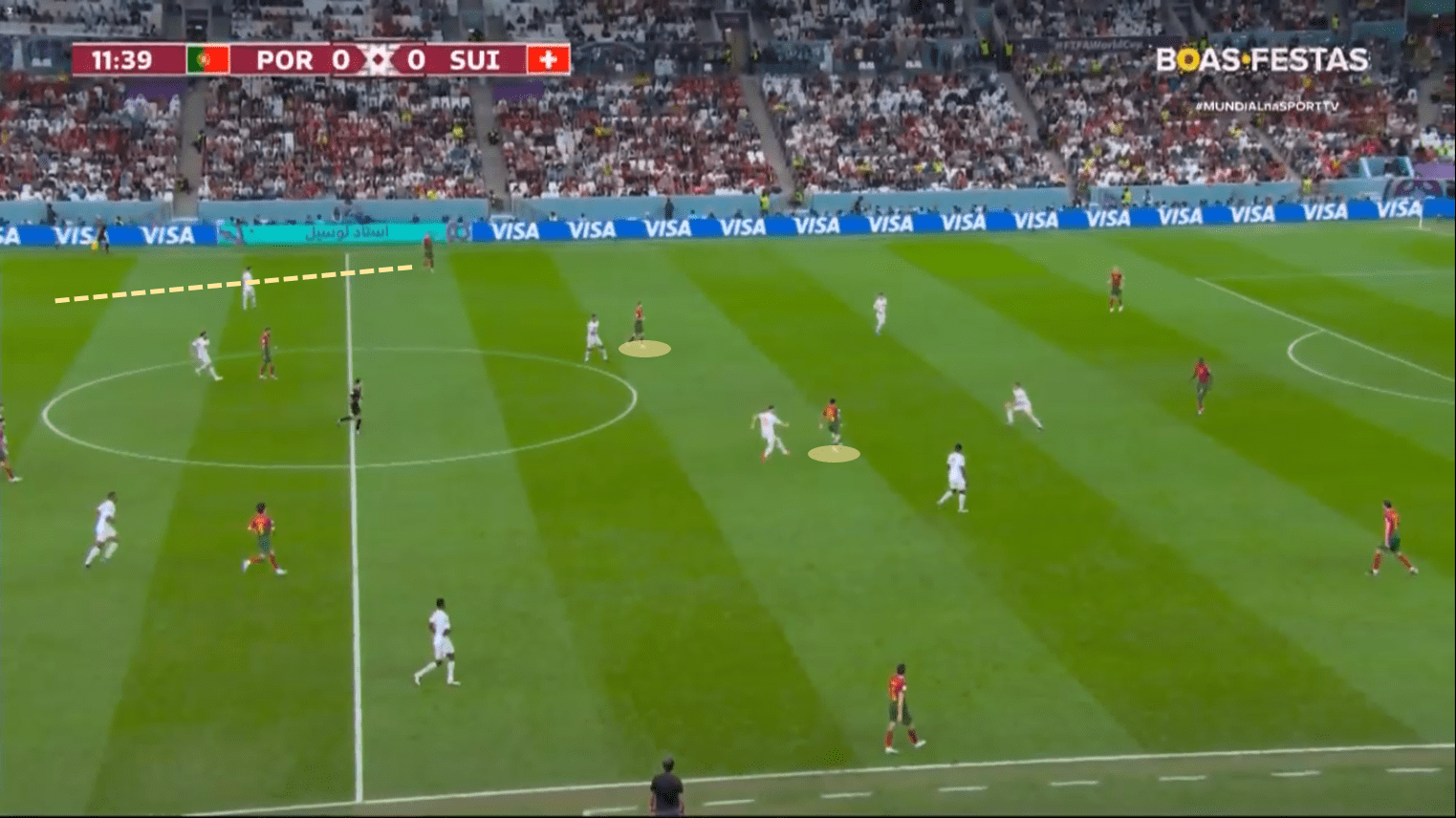
The rotations did not stop being carried out and they worked in a great way for Portugal. The players coexisted in a great way in improvised movements on their part which, with the agility and creativity they have both physically and mentally, was far superior to what Switzerland expected in defending itself.
At times, Bernardo Silva in the last third of the field could take the position of #10, being this the one who entered the area, in a role that he has already played with his club. Guerreiro was not so open to generating the 2v1 but he functioned more as a midfielder and Felix could play the role of a wider player. It was something that Switzerland could not stop even with the most rigid block.
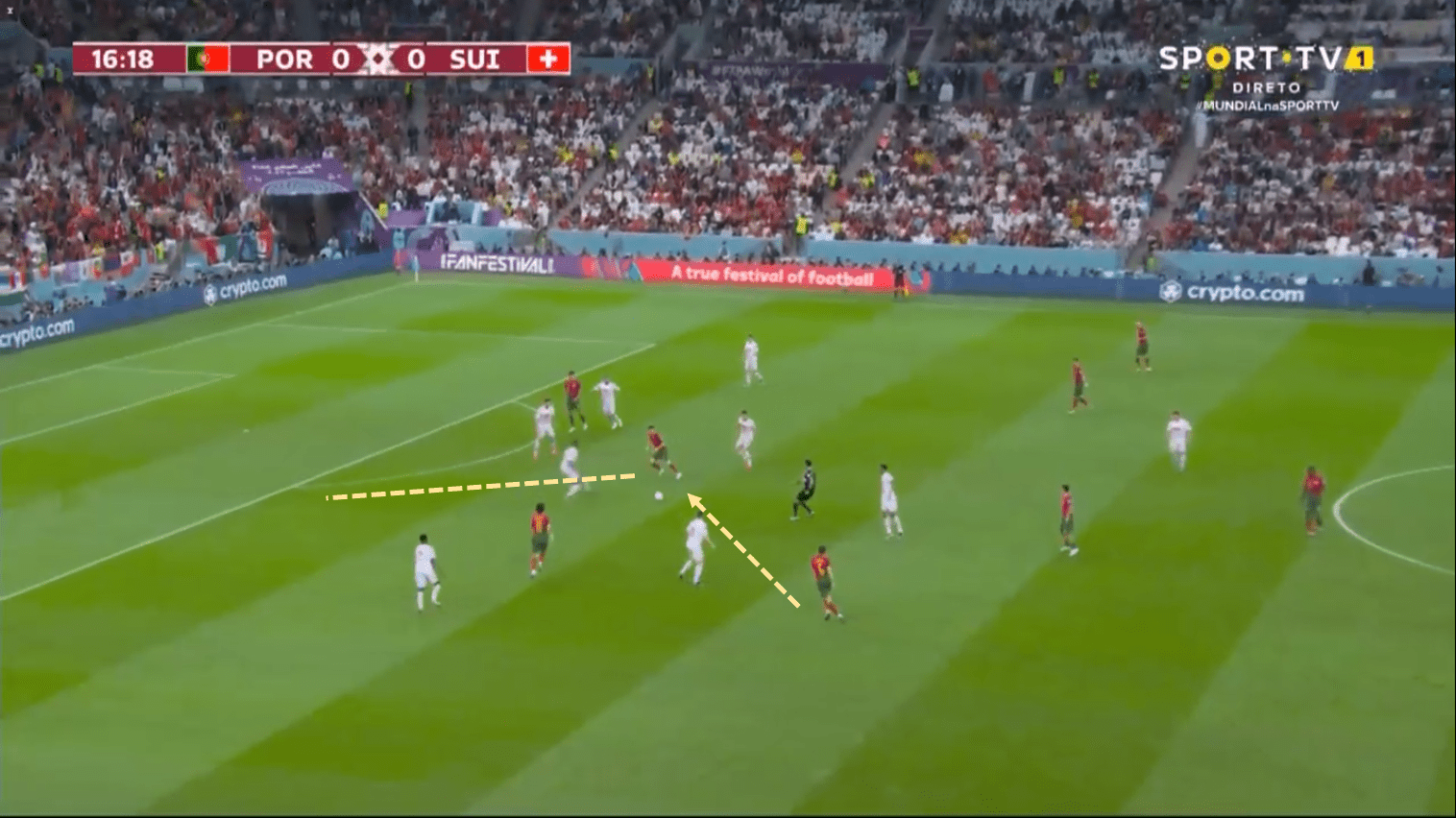
Even when Switzerland thought they had already found some predetermined moves in build-ups and in attack, with the inverted full-back on one side, the other open, the striker always pinning through the middle to both central defenders, and the stay of one of the players like the #10, this kept changing.
In this figure, we can see how Bernardo Silva is the one who takes the most open place on the left flank, with Guerreiro making underlapping runs and Joao Felix being the closest player to them as a #10, which is a role that he fits exceptionally, as well as Bruno, Bernardo or even Otavio who sometimes went higher up the thirds.
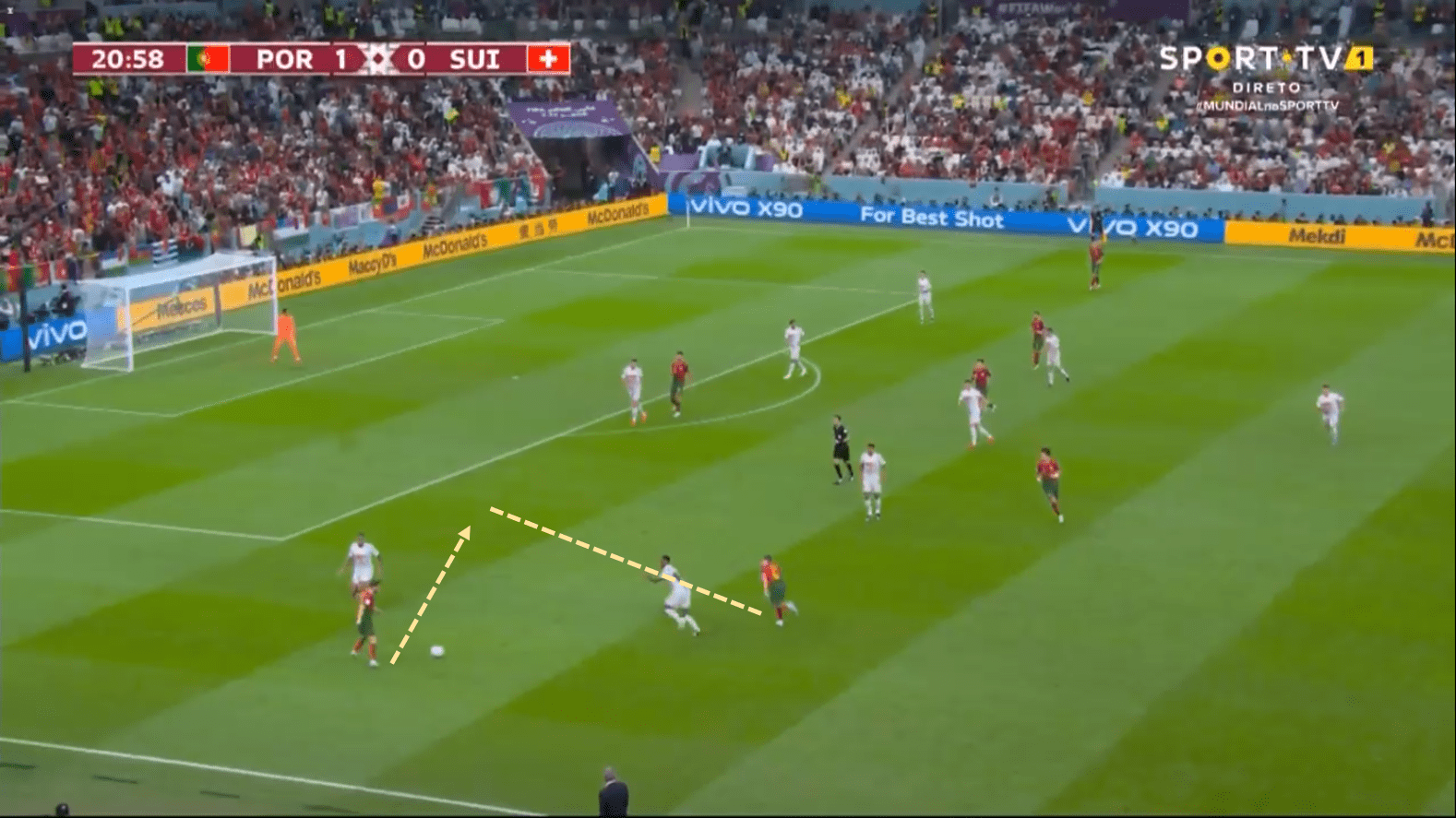
In the preview of Portugal’s second goal, which was scored by Pepe after a delivery from a corner kick, the play was similar to what is mentioned above: Guerreiro again made the underlapping movement, thus seeking to receive there to the centre of the box or to drag the mark and create confusion, thus leaving space for Felix to act with the ball.
The one who in this case took the closest player place was, precisely the aforementioned Otavio, who after taking the ball with time and space, decided to run and climb heights from the middle to the final third, to release the ball to Félix, who sent a very dangerous cross that was cleared out to a corner-kick that would end in the 2-0 scored by Portuguese legend, Pepe.
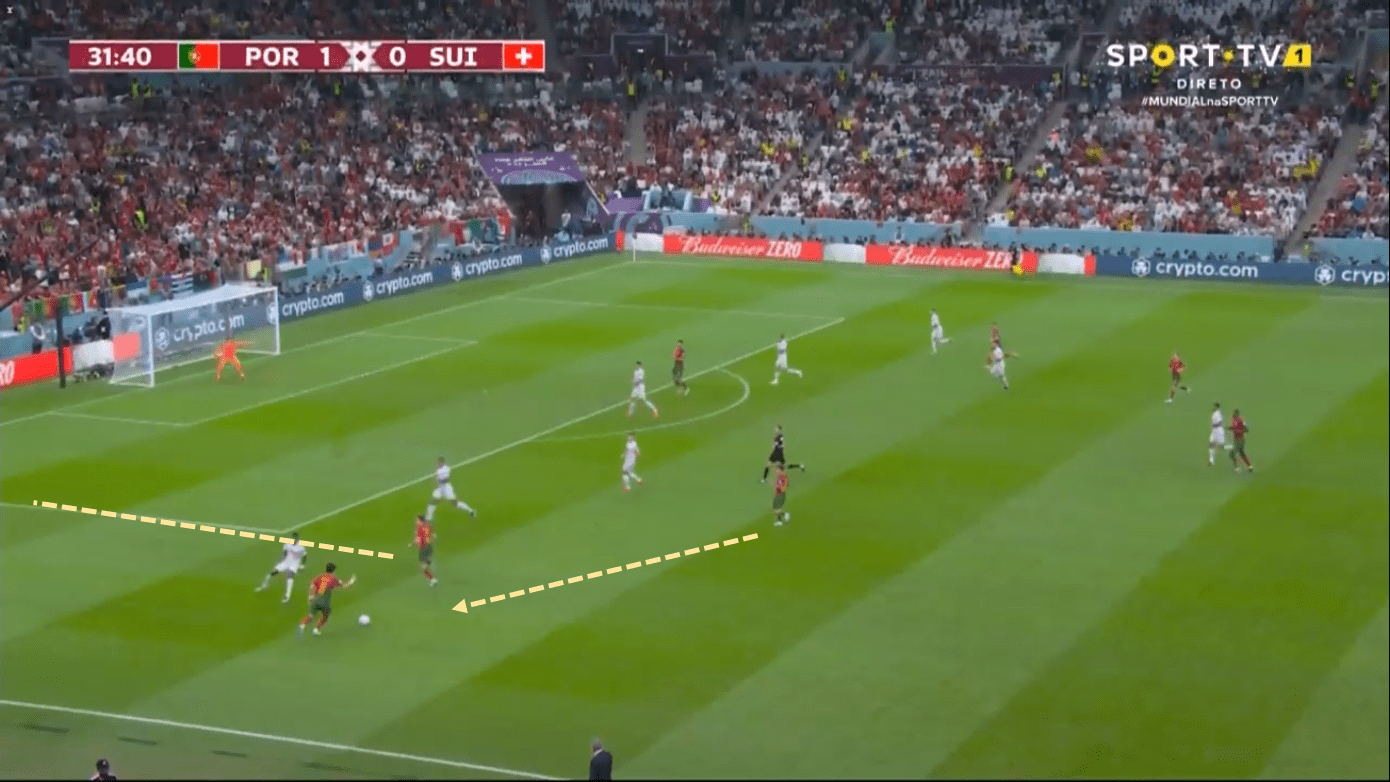
The previous to the third goal, scored by Goncalo Ramos, which was his second goal of the match, was coincidentally thanks to this triangle that was generated not totally open on the side but on the edge of the box and in the half-space.
In this case, the triangulation was created through Bruno Fernandes, who, after getting out of tight spaces, was able to carry the ball forward, where he found Bernardo Silva coming up close to him, and Guerreiro again attracting the marking with their underlapping runs that did a lot of damage to Switzerland. After two touches between Bernardo and Bruno, which executed a cross that was sent and rejected, which fell to Dalot who, as a wide full-back, resolved with a 1v1 dribbling and cross into the middle of the box.
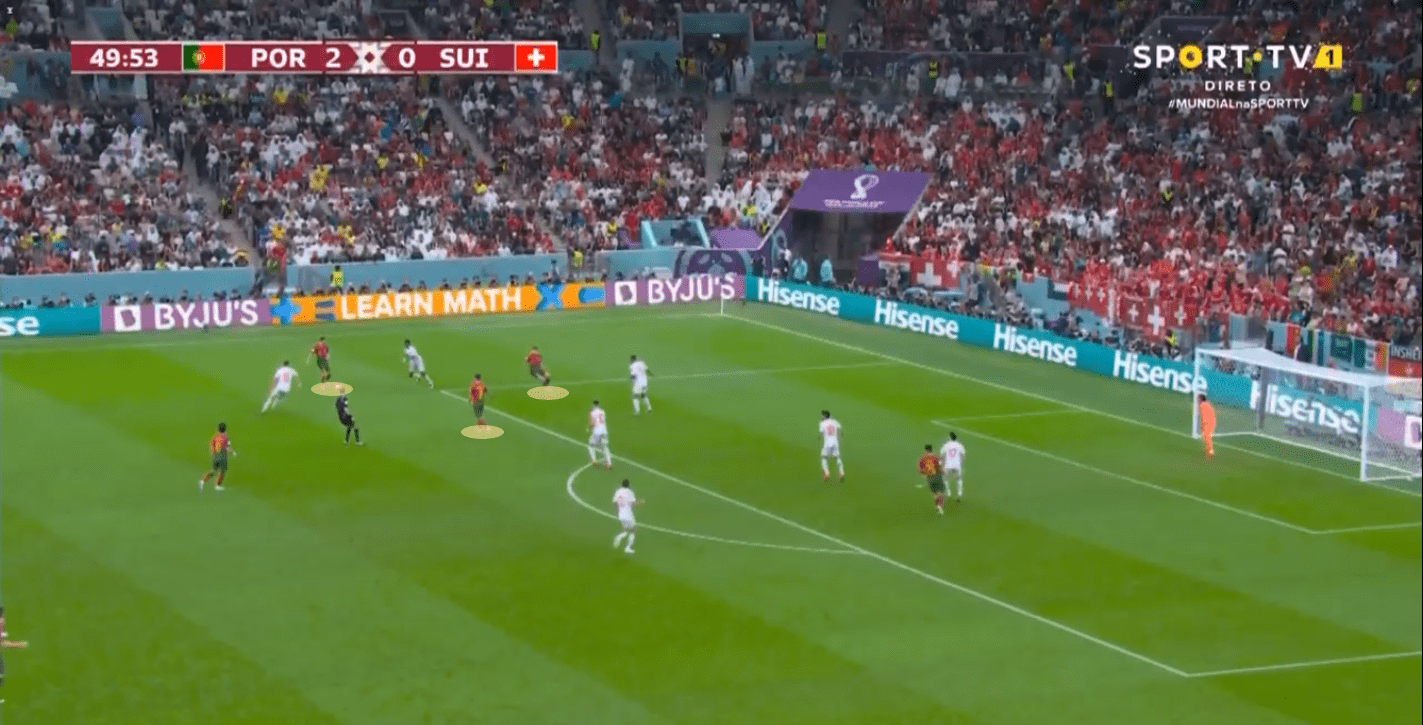
Finally, Raphael Guerreiro’s movements inside the half-space gave the Borussia Dortmund player a chance in terms of contributing to a goal, who, after a quick two-touch exit from Portugal, managed to be activated into space with his underlapping runs.
However, the play was extremely interesting and again, quite rotational. Joao Felix was the first outside pass on the wing, which found Otavio more advanced, who took the ball at heights where Bernardo, Felix himself or Bruno acted, and returned it to the Atlético de Madrid player so that he released the space for Guerreiro, who also had the participation of Ramos in an excellent first-time pass playing with his back.
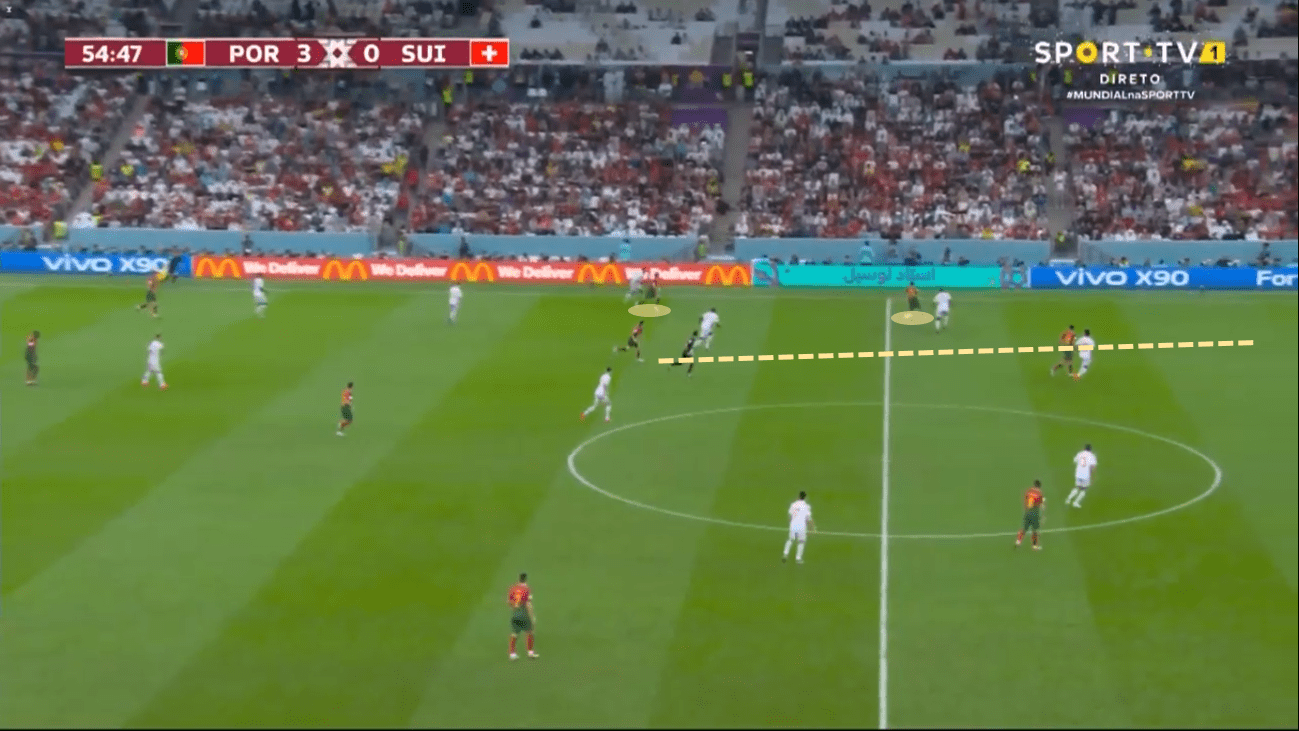
Portugal used a fairly aggressive pressing structure that shifted from midfield man-marking to something more zonal on the part of some players, especially the front row, who were working in a role of more waiting to pull the trigger when the ball is played to one of the Swiss central defenders.
Joao Felix took one of them, like Goncalo Ramos from the other load, while Bernardo Silva, who is quite intense with his pressure, covered the option of passing with his #6, which eliminated the progression of Switzerland where they usually seek to do so. Further back and quite a few apart, Bruno took one of the midfielders in a man-marking just like Otavio. While Carvalho remained in zonal marking and Dalot joined the central line seeking to generate superiority.
If the ball was played out wide, Guerreiro jumped off aggressively to win the ball back, knowing that he was going to have cover behind with one of the centre-backs or even Carvalho that didn’t have a man-mark responsibility.
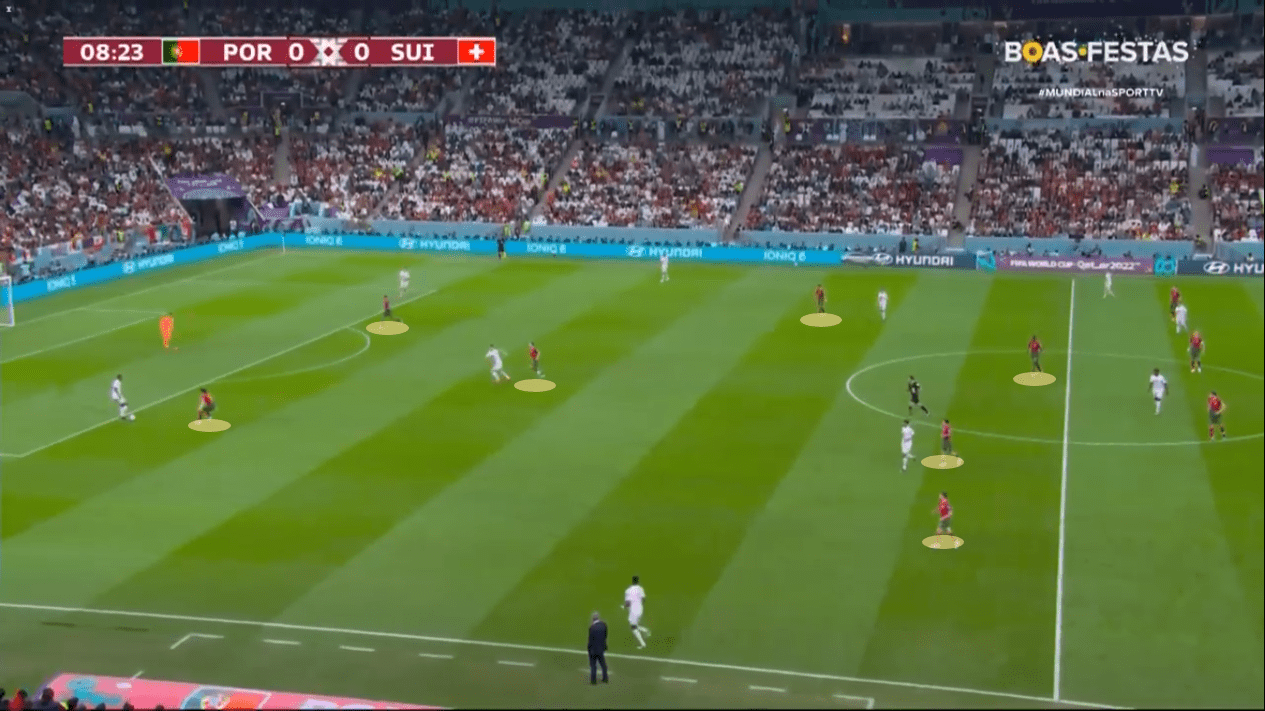
Portugal won the game with three goals from Goncalo Ramos who, with his intensity, simple link-up play within one or two touches, in addition to his accurate finishing in front of the goal in each one had provided a lot and something that was missing in said area for those of Fernando Santos. While in addition to the rotational game, the defensive part of him was extremely solid and quite coordinated as well as very focused on each of the eleven elements.
Conclusion
With this change in the mentality of Fernando Santos to a more hybrid and mobile system with the ball, they are clearly one of the favourites of the tournament with the squad they have in their hands, of great quality and a lot of talent to keep the ball and combine in very quick. Something that will have to see how Morocco will stop, after knocking out Spain who were very flat inside their game idea against the Africans.






Comments